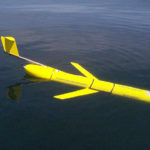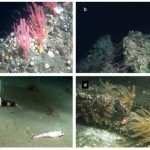This is first in a series of five referenced articles about shared characteristics in deep-sea and shallow-water corals.
 Deep-sea corals are benthic suspension feeders in the classes Anthozoa and Hydrozoa. They share the Phylum Cnidaria along with the jellyfish, sea anemones, and the siphonophores. Cnidarians all share one common trait, a stinging cell called the cnidocite, which is the fastest known biological structure (1) and the unparalleled apex of organelle specialization (2).
Deep-sea corals are benthic suspension feeders in the classes Anthozoa and Hydrozoa. They share the Phylum Cnidaria along with the jellyfish, sea anemones, and the siphonophores. Cnidarians all share one common trait, a stinging cell called the cnidocite, which is the fastest known biological structure (1) and the unparalleled apex of organelle specialization (2).
Cnidocite structures, aka nematocysts, or stinging cells, are housed within the tentacles of the polyps. Together they snare and poison prey. One example of polypoid architecture is shown at left. Some coral polyps (like these) have eight tentacles, and some have six, or two. The Phylum Cnidaria has been called “the explosive” in the Cambrian Explosion (2).
Corals are cnidarians with calcitic and/or horn-like skeletal elements (3). They come in many shapes and forms, including solitary cup corals and massive, platelike, and arborescent colonies in the Scleractinia. Black and gold corals are antipatharian and zoantharian corals, respectively. The octocorals are sometimes known as soft corals. The octocorals include the gorgonacea, or sea fans, and the gelatinous Neptheids common in the Indo-Pacific and Red Sea. The Stylasterids are hydrozoans. Like the gorgonacea, these are particularly diverse in high latitude temperate waters.
Corals are species rich. They comprise 5080 species, 2/3 of which occur deeper than 50m (3). Scleractinian corals are indicators of biodiversity in shallow tropical reef studies (4), but there are twice as many octocoral species worldwide, with 2800 species of octocorals (Alcyonaria) versus 1500 species of scleractinian hexacorals (Zoantharia), if you combine shallow-water and deep-water species from each subclass (S. Cairns, Smithsonian NMNH, pers. comm.). That is, most coral species occur in deep-water.
This idea may be contrary to popular opinion, but both the hard scleractinian hexacorals and the softer gorgonaceous octocorals have vertical ranges exceeding 6000m. They also range worldwide, from the equator to the poles (5). Most of the azooxanthellate Scleractinia are solitary in form, and these are most abundant at 200-1000m (3). Therefore, most corals occur in deep-water, and this is where they reach their highest abundance.
Sclercatinian corals are the subject of the most comprehensive distribution studies. From what scientists have put together, shallow water species richness is not evenly distributed over the Earth, but rather concentrated in two epicenters of biodiversity, 1) the Indo-Pacific Coral Triangle with nearly 500 species of scleractinia and 2) the Western Atlantic Caribbean Sea with about 50 species. Species richness declines outward in all directions from these poles (6). Recently, it has been shown that deep water azooxanthellate corals follow this same general pattern in richness, with a maximum richness of 157 species in the Coral Triangle, and 80 species in the Western Atlantic (3).
 The incredible richness of coral species is matched only by their beauty. Anyone who has been snorkeling on tropical reefs knows that corals are remarkably colorful under visible light. However, they can be downright psychedelic under fluorescent light (7). Naturally fluorescing proteins occur in a wide range of shallow and deep-water cnidarian forms. For deep-water corals, the gorgonian “bamboo corals” in the subfamily Keratoisidinae are best known for their flashes of bioluminescence upon excitation (8, 9).
The incredible richness of coral species is matched only by their beauty. Anyone who has been snorkeling on tropical reefs knows that corals are remarkably colorful under visible light. However, they can be downright psychedelic under fluorescent light (7). Naturally fluorescing proteins occur in a wide range of shallow and deep-water cnidarian forms. For deep-water corals, the gorgonian “bamboo corals” in the subfamily Keratoisidinae are best known for their flashes of bioluminescence upon excitation (8, 9).
The colorful appearance of shallow and deep water corals has won them a following not only among scientists, but also among aquarium hobbyists, non-profit organizations, and federal management authorities. Like shallow corals, deep-water corals have proven an effective “flagship species”, chosen to represent an environmental cause, such as an ecosystem in need of conservation (10). As this series continues, you will learn more about corals ecosystem functions and their scientific utility. Hopefully you will come to identify with deep-corals the same way you identify with shallow coral reefs. Deep-corals are also in trouble, and they need our help and support.
References:
1. Boero et al. 2007. Cnidarian milestones in metazoan evolution. Int Comp Bio 47:5.
2. Tardent, P. 1995. The cnidarian cnidocyte, a high-tech cellular weaponry. Bioessays
17(4): 351- 362.
3. Cairns, SD. 2007. Deep-water corals: An Overview with special reference to diversity and distribution of deep-water scleractinian corals. Bull Mar Sci 81(3): 311-322.
4. Roberts, CM et al. 2002. Marine Biodiversity Hotspots and Conservation Priorities for Tropical Reefs. Science, 295 (5558): 1280-1284.
5. Bayer, FM. 1956. Octocorallia. in RC Moore (ed), Treatise on invertebrate paleontology. Part F Coelenterata. University of Kansas Press.
6. Veron, JEN. 1995. Corals in Space and Time. Cornell University Press; Ithaca, NY. 321pp.
7. Mazel, C.H., 1995. Spectral measurements of fluorescence emission in Caribbean cnidarians. Mar. Ecol. Prog. Ser., 120:185-191.
8. Muzik, K. 1978. A bioluminescent gorgonian, Lepidisis olapa, new species (Coelenterata: Octocorallia), from Hawaii. Bull. Mar. Sci. 28(4): 735-741.
9. Eye in the Sea Research Group, 2004. NOAA Office of Ocean Exploration website article.
10. Wikipedia. Accessed Jan 15, 2007. http://en.wikipedia.org/w/index.php?title=Flagship_species&oldid=119777223
Share the post "Deep-sea corals are rich and beautiful, like their shallow tropical counterparts"






Just because they pay attention to their appearance doesn’t mean they’re shallow!